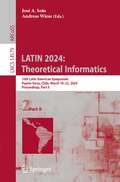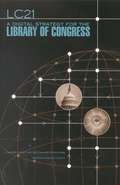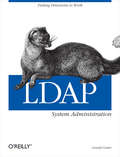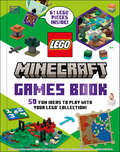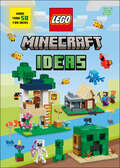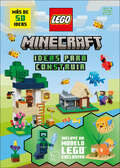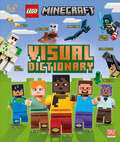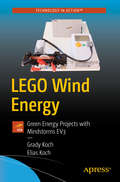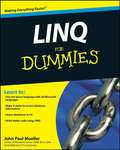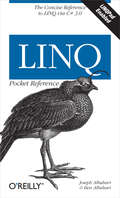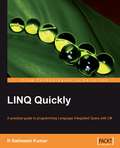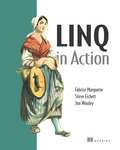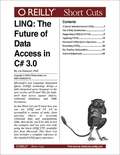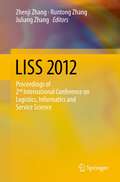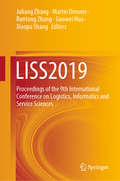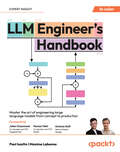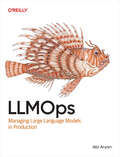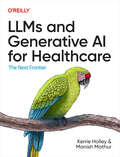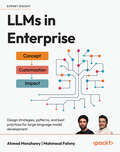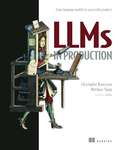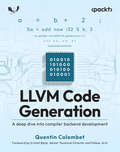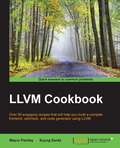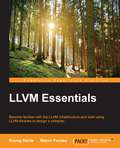- Table View
- List View
LATIN 2024: 16th Latin American Symposium, Puerto Varas, Chile, March 18–22, 2024, Proceedings, Part II (Lecture Notes in Computer Science #14579)
by Andreas Wiese José A. SotoThis book constitutes the proceedings of the 16th Latin American Symposium on Theoretical Informatics, LATIN 2042, which took place in Puerto Varas, Chile, in March 2024. The 44 papers presented in this volume were carefully reviewed and selected from 93 submissions. They were organized in topical sections as follows:Part I: Algorithms and Data Structures; Approximation and Online Algorithms; Complexity Theory; Part II: Combinatorics and Graph Theory; Parameterized Algorithms; Automata Theory and Formal Languages; and Game Theory and Fairness.
LC21: A Digital Strategy for the Library of Congress
by National Research CouncilDigital information and networks challenge the core practices of libraries, archives, and all organizations with intensive information management needs in many respects-not only in terms of accommodating digital information and technology, but also through the need to develop new economic and organizational models for managing information. LC21: A Digital Strategy for the Library of Congress discusses these challenges and provides recommendations for moving forward at the Library of Congress, the world's largest library. Topics covered in LC21 include digital collections, digital preservation, digital cataloging (metadata), strategic planning, human resources, and general management and budgetary issues. The book identifies and elaborates upon a clear theme for the Library of Congress that is applicable more generally: the digital age calls for much more collaboration and cooperation than in the past. LC21 demonstrates that information-intensive organizations will have to change in fundamental ways to survive and prosper in the digital age.
LDAP System Administration
by Gerald CarterWith the potential to consolidate existing network services into a single directory, Lightweight Directory Access Protocol (LDAP) is exactly what overburdened system administrators have been waiting for. But LDAP can also be a headache for those trying to master the technology. LDAP System Administration takes a hands-on approach, providing system administrators with the tools they need to understand and implement LDAP. Author Jerry Carter talks about using directories for Unix system administration-specifically, the OpenLDAP directory-but the skills he teaches are also applicable to LDAP products from Microsoft, Sun, and Novell. His book tells readers how to get the directory running, how to get data into the directory, how to use a directory to replace local username and password lookups, and many other critical LDAP skills.
LDAP System Administration: Putting Directories to Work
by Gerald CarterBe more productive and make your life easier. That's what LDAP System Administration is all about.System administrators often spend a great deal of time managing configuration information located on many different machines: usernames, passwords, printer configurations, email client configurations, and network filesystem configurations, to name a few. LDAPv3 provides tools for centralizing all of the configuration information and placing it under your control. Rather than maintaining several administrative databases (NIS, Active Directory, Samba, and NFS configuration files), you can make changes in only one place and have all your systems immediately "see" the updated information.Practically platform independent, this book uses the widely available, open source OpenLDAP 2 directory server as a premise for examples, showing you how to use it to help you manage your configuration information effectively and securely. OpenLDAP 2 ships with most Linux® distributions and Mac OS® X, and can be easily downloaded for most Unix-based systems. After introducing the workings of a directory service and the LDAP protocol, all aspects of building and installing OpenLDAP, plus key ancillary packages like SASL and OpenSSL, this book discusses:Configuration and access controlDistributed directories; replication and referralUsing OpenLDAP to replace NISUsing OpenLDAP to manage email configurationsUsing LDAP for abstraction with FTP and HTTP servers, Samba, and RadiusInteroperating with different LDAP servers, including Active DirectoryProgramming using Net::LDAPIf you want to be a master of your domain, LDAP System Administration will help you get up and running quickly regardless of which LDAP version you use. After reading this book, even with no previous LDAP experience, you'll be able to integrate a directory server into essential network services such as mail, DNS, HTTP, and SMB/CIFS.
LDPC Code Designs, Constructions, and Unification
by William E. Ryan Shu Lin Juane Li Khaled Abdel-Ghaffar Daniel J. CostelloWritten by leading experts, this self-contained text provides systematic coverage of LDPC codes and their construction techniques, unifying both algebraic- and graph-based approaches into a single theoretical framework (the superposition construction). An algebraic method for constructing protograph LDPC codes is described, and entirely new codes and techniques are presented. These include a new class of LDPC codes with doubly quasi-cyclic structure, as well as algebraic methods for constructing spatially and globally coupled LDPC codes. Authoritative, yet written using accessible language, this text is essential reading for electrical engineers, computer scientists and mathematicians working in communications and information theory.
LEGO Minecraft Games Book: 50 Fun Ideas to Play with Your LEGO Collection!
by Julia MarchThis edition does not include LEGO elements.Keep the whole family entertained with 50 ideas for LEGO® Minecraft® themed games, puzzles, and challenges!Challenge friends to a Nether minecart race. Find the odd crafting block out. Design your own LEGO Minecraft fairground. And much more!Get ready to level up the fun with your friends and family:ALL-NEW GAME IDEAS: Explore 50 brand-new LEGO Minecraft models and ideas for games, challenges, and puzzles – perfect for playing with family, friends, or on your ownSOMETHING FOR EVERYONE: The activities and games are great for all ages, making this the perfect gift for young LEGO builders and avid Minecraft fans alikeBuild in some time for bite-sized family fun with the LEGO Minecraft Games Book, packed with hours’ worth of ideas for LEGO Minecraft games, puzzles, and challenges. Also included are 61 Minecraft themed LEGO elements to add to your own collection and use alongside the games in the book, making this the ultimate experience for fun-loving LEGO Minecraft enthusiasts.©2025 The LEGO Group.©2025 Mojang AB.
LEGO Minecraft Ideas (Lego Ideas)
by Julia March Shari LastLevel up your LEGO® Minecraft® models with more than 50 building ideas!Use your LEGO collection to bring your Minecraft builds to life. Inspire budding builders to design a diamond sword, build a busy biome, make a micro mob, create a creeper house, and much more. Challenge family and friends to exciting games that combine the best bits of Minecraft and LEGO building.© 2024 Mojang AB ©2024 The LEGO Group.
LEGO Minecraft Ideas para construir: Incluye un modelo LEGO Exclusivo
by Julia March¡Pasa al siguiente nivel y lleva a cabo tus construcciones LEGO® Minecraft como un experto con más de 50 ideas de construcción!Level up your LEGO Minecraft builds with more than 50 byte-size building ideas!¡Pasa al siguiente nivel y lleva a cabo tus construcciones LEGO® Minecraft como un experto con más de 50 ideas de construcción!¡LEGO® y Minecraft son la combinación perfecta para futuros constructores, creadores e inventores! Este libro te muestra cómo utilizar tu colección de ladrillos LEGO® para darle vida a tus construcciones favoritas de Minecraft.Inspírate para diseñar una guarida, crear un castillo o hacer una casa en el árbol con más de 50 ideas increíbles. Desafía a familiares y amigos a emocionantes juegos que combinan lo mejor de Minecraft y la construcción con LEGO®.©2025 Mojang AB.©2025 The LEGO Group.------------------------------------------------------------------------------------Level up your LEGO Minecraft builds with more than 50 byte-size building ideas!LEGO and Minecraft are the perfect match for budding builders, creators, and inventors. This book shows readers how to use their LEGO brick collection to bring their Minecraft builds to life. Be inspired to design a den, create a castle, make a treehouse, and much more with over 50 amazing ideas. Challenge family and friends to exciting games that combine the best bits of Minecraft and LEGO building.© 2023 Mojang AB.©2023 The LEGO Group.
LEGO Minecraft Visual Dictionary
by Elizabeth Dowsett Craig JelleyExplore the adventurous world of LEGO® Minecraft® in DK’s beloved Visual Dictionary format!Journey through 13 years of LEGO Minecraft and discover everything you need to know about its iconic locations, items, and mobs. See every brick-built detail of the hostile warden, investigate the Iron Golem Fortress, and uncover different biomes’ flora and fauna – and much, much more!A must-own Minecraft book for kids, complete with everything you need to know:A complete look back on 13 years of LEGO Minecraft, packed with information on key sets and minifigures, behind-the-scenes content, concept art, and an exclusive interview with the LEGO Minecraft teamThe perfect gift for LEGO Minecraft fans young and old, with everything you need to know about this popular franchiseMinifigure not included in this ebook editionLearn all about your favorite LEGO Minecraft characters and mobs – from Alex and Steve to villagers and creepers – as you meet the LEGO Minecraft team and uncover exclusive behind-the-scenes facts.For LEGO Minecraft fans, all you need to know is right here!TM & © Mojang AB.©2025 The LEGO Group.
LEGO Wind Energy: Green Energy Projects with Mindstorms EV3
by Grady Koch Elias KochBuild functioning wind turbines that generate electricity; we don’t mean LEGO models that look like miniature wind turbines. This book is for people who want to learn how real turbines work, and to build them using LEGO and Mindstorms EV3. You’ll find specific instructions on building, links to parts purchasing, distillation of complex science ideas into practice, and pointers for trying something new. With the knowledge you gain here, you’ll be able to compete in turbine design competitions, such as the KidWind Challenge, Collegiate Wind Competition, and locally organized contests. Examples are given that fit within the KidWind Challenge, including adherence to rules of the competition such as that a specific generator be used.The complexity of making a wind turbine a can make it difficult to know where to start. This book addresses many aspects of the turbine with practical examples. You'll follow specific design instructions for turbine construction, supported by suggestions and background science to go in new directions. Assembly diagrams are used throughout, made with the Studio utility from bricklink.com. Parts are identified in the assembly diagram, as well as in parts lists in the Appendix.What You'll LearnBuild a turbine from scratchUse LEGO to learn aspects of electrical engineering, such as loading turbine output and impedance matchingConnect a generator to do useful things such as charging a battery or powering LEDs See how generators, gear systems, aerodynamic blades, lab and outdoor testing, and power output are used.Who This Book Is For Adult fans of LEGO and hardware hackers. Also coaches or students involved in a school science/technology project or design competition.
LINQ For Dummies
by John Paul MuellerIf you've asked yourself "Why can't I develop database and XML queries in a language I already know?", then Language INtegrated Query, or LINQ, is for you. LINQ For Dummies introduces you to LINQ and the .NET Framework technologies, so you can use LINQ to query any object, any data set, any kind of XML, and SQL Server--no questions asked.This plain-English guide gives you a thorough overview of LINQ, from understanding the tasks it performs to making LINQ work with both Visual Basic and Visual Studio 2005. It explains the four LINQ providers in the .NET Framework, the easiest ways to go about accessing data, and how to write more efficient applications with less code using LINQ. There's also clear guidance on combining third-party providers with LINQ to create even more powerful apps. With this single, comprehensive guide, you'll discover how to:Use one query language with all Microsoft languagesExamine .NET language extensions and work with extension methods, partial methods, lambda expressions, and query expressionsLINQ to DataSet operators, SQL server operations, XML API, or Active DirectoryDeal with databases -- download and install the Northwind database, generate Northwind entity classes, and create the Northwind XML mapping fileCreate the partial class example, the partial method example, and the database modification exampleUse objects with LINQQuery databases in Visual Basic and C#As an added bonus, you can visit the companion Web site for LINQ examples in C# and Visual Basic. With LINQ For Dummies, you'll link up with LINQ in no time and see how you can query almost anything!Note: CD-ROM/DVD and other supplementary materials are not included as part of eBook file.
LINQ Pocket Reference: Learn and Implement LINQ for .NET Applications (Pocket Reference (O'Reilly))
by Ben Albahari Joseph AlbahariReady to take advantage of LINQ with C# 3.0? This guide has the detail you need to grasp Microsoft's new querying technology, and concise explanations to help you learn it quickly. And once you begin to apply LINQ, the book serves as an on-the-job reference when you need immediate reminders.All the examples in the LINQ Pocket Reference are preloaded into LINQPad, the highly praised utility that lets you work with LINQ interactively. Created by the authors and free to download, LINQPad will not only help you learn LINQ, it will have you thinking in LINQ.This reference explains:LINQ's key concepts, such as deferred execution, iterator chaining, and type inference in lambda expressionsThe differences between local and interpreted queriesC# 3.0's query syntax in detail-including multiple generators, joining, grouping, query continuations, and moreQuery syntax versus lambda syntax, and mixed syntax queries Composition and projection strategies for complex queriesAll of LINQ's 40-plus query operatorsHow to write efficient LINQ to SQL queriesHow to build expression trees from scratchAll of LINQ to XML's types and their advanced useLINQ promises to be the locus of a thriving ecosystem for many years to come. This small book gives you a huge head start."The authors built a tool (LINQPad) that lets you experiment with LINQ interactively in a way that the designers of LINQ themselves don't support, and the tool has all kinds of wonderful features that LINQ, SQL and Regular Expression programmers alike will want to use regularly long after they've read the book."-Chris Sells, Connected Systems Program Manager, Microsoft
LINQ Quickly
by Satheesh N. KumarThis book introduces the reader to the basic concepts of LINQ, and takes them through using LINQ with an example-driven approach. This book is for .NET developers who want to find out exactly what LINQ is, what it can do for them, and how to program with LINQ. This book presumes a sound knowledge of XML, ADO.NET, and .NET data access" No knowledge of LINQ is presumed.
LINQ in Action
by Steve Eichert James B. Wooley Fabrice MarguerieLLINQ, Language INtegrated Query, is a new extension to the Visual Basic and C# programming languages designed to simplify data queries and database interaction. It addreses O/R mapping issues by making query operations like SQL statements part of the programming language. It also offers built-in support for querying in-memory collections like arrays or lists, XML, DataSets, and relational databases.LINQ in Action is a fast-paced, comprehensive tutorial for professional developers. This book explores what can be done with LINQ, shows how it works in an application, and addresses the emerging best practices. It presents the general purpose query facilities offered by LINQ in the upcoming C# 3.0 and VB.NET 9.0 languages. A running example introduces basic LINQ concepts. You'll then learn to query unstructured data using LINQ to XML and relational data with LINQ to SQL. Finally, you'll see how to extend LINQ for custom applications.LINQ in Action will guide you along as you explore this new world of lambda expressions, query operators, and expression trees. As well, you'll explore the new features of C# 3.0, VB.NET 9.0. The book is very practical, anchoring each new idea with running code. Whether you want to use LINQ to query objects, XML documents, or relational databases, you will find all the information you need to get startedBut LINQ in Action does not stop at the basic code. This book also shows you how LINQ can be used for advanced processing of data, including coverage of LINQ's extensibility, which allows querying more data sources than those supported by default. All code samples are built on a concrete business case. The running example, LinqBooks, is a personal book cataloging system that shows you how to create LINQ applications with Visual Studio 2008. Purchase of the print book comes with an offer of a free PDF, ePub, and Kindle eBook from Manning. Also available is all code from the book.
LINQ: The Future of Data Access in C# 3.0
by Joe HummelLanguage Integrated Query (LINQ) is Microsoft's new technology for powerful, general purpose data access. This technology provides a fully-integrated query language, available in both C# 3.0 and VB 9.0, for high-level data access against objects, relational databases, and XML documents.In this Short Cut you'll learn about LINQ and the proposed C# 3.0 extensions that support it. You'll also see how you can use LINQ and C# to accomplish a variety of tasks, from querying objects to accessing relational data and XML. Best of all, you'll be able to test the examples and run your own code using the latest LINQ CTP, available free from Microsoft. This Short Cut includes a complete reference to the standard LINQ query operators.
LISS 2012
by Juliang Zhang Runtong Zhang Zhenji ZhangInformation and communication technology has helped to provide a more effective network infrastructure and development platform for logistics and service operations. In order to meet the needs of consumers, and particularly to promote low-carbon development processes, new types of services will also emerge. LISS 2012 is a prime international forum for both researchers and industry practitioners to exchange the latest fundamental advances in the state of the art and practice of logistics, informatics, service operations and service science. Experts and researchers from related fields will discuss current issues and future development opportunities, discuss and analyze developing trends and exchange the latest research and academic thought. The theme of the conference is Logistics and Service Science based on the Internet of Things.
LISS2019: Proceedings of the 9th International Conference on Logistics, Informatics and Service Sciences
by Juliang Zhang Runtong Zhang Guowei Hua Martin Dresner Xiaopu ShangThis book focuses on AI and data-driven technical and management innovations in logistics, informatics and services. The respective papers analyze in detail the latest fundamental advances in the state of the art and practice of logistics, informatics, service operations and service science. The book gathers the outcomes of the “9th International Conference on Logistics, Informatics and Service Sciences,” which was held at the University of Maryland, USA.
LLM Engineer's Handbook: Master the art of engineering large language models from concept to production
by Maxime Labonne Paul IusztinStep into the world of LLMs with this practical guide that takes you from the fundamentals to deploying advanced applications using LLMOps best practicesKey FeaturesBuild and refine LLMs step by step, covering data preparation, RAG, and fine-tuningLearn essential skills for deploying and monitoring LLMs, ensuring optimal performance in productionUtilize preference alignment, evaluation, and inference optimization to enhance performance and adaptability of your LLM applicationsBook DescriptionArtificial intelligence has undergone rapid advancements, and Large Language Models (LLMs) are at the forefront of this revolution. This LLM book offers insights into designing, training, and deploying LLMs in real-world scenarios by leveraging MLOps best practices. The guide walks you through building an LLM-powered twin that’s cost-effective, scalable, and modular. It moves beyond isolated Jupyter notebooks, focusing on how to build production-grade end-to-end LLM systems. Throughout this book, you will learn data engineering, supervised fine-tuning, and deployment. The hands-on approach to building the LLM Twin use case will help you implement MLOps components in your own projects. You will also explore cutting-edge advancements in the field, including inference optimization, preference alignment, and real-time data processing, making this a vital resource for those looking to apply LLMs in their projects. By the end of this book, you will be proficient in deploying LLMs that solve practical problems while maintaining low-latency and high-availability inference capabilities. Whether you are new to artificial intelligence or an experienced practitioner, this book delivers guidance and practical techniques that will deepen your understanding of LLMs and sharpen your ability to implement them effectively.What you will learnImplement robust data pipelines and manage LLM training cyclesCreate your own LLM and refine it with the help of hands-on examplesGet started with LLMOps by diving into core MLOps principles such as orchestrators and prompt monitoringPerform supervised fine-tuning and LLM evaluationDeploy end-to-end LLM solutions using AWS and other toolsDesign scalable and modularLLM systemsLearn about RAG applications by building a feature and inference pipelineWho this book is forThis book is for AI engineers, NLP professionals, and LLM engineers looking to deepen their understanding of LLMs. Basic knowledge of LLMs and the Gen AI landscape, Python and AWS is recommended. Whether you are new to AI or looking to enhance your skills, this book provides comprehensive guidance on implementing LLMs in real-world scenarios
LLMOps: Managing Large Language Models in Production
by Abi AryanHere's the thing about large language models: they don't play by the old rules. Traditional MLOps completely falls apart when you're dealing with GenAI. The model hallucinates, security assumptions crumble, monitoring breaks, and agents can't operate. Suddenly you're in uncharted territory. That's exactly why LLMOps has emerged as its own discipline. LLMOps: Managing Large Language Models in Production is your guide to actually running these systems when real users and real money are on the line. This book isn't about building cool demos. It's about keeping LLM systems running smoothly in the real world. Navigate the new roles and processes that LLM operations require Monitor LLM performance when traditional metrics don't tell the whole story Set up evaluations, governance, and security audits that actually matter for GenAI Wrangle the operational mess of agents, RAG systems, and evolving prompts Scale infrastructure without burning through your compute budget
LLMs and Generative AI for Healthcare: The Next Frontier
by Kerrie Holley Manish MathurLarge language models (LLMs) and generative AI are rapidly changing the healthcare industry. These technologies have the potential to revolutionize healthcare by improving the efficiency, accuracy, and personalization of care. This practical book shows healthcare leaders, researchers, data scientists, and AI engineers the potential of LLMs and generative AI today and in the future, using storytelling and illustrative use cases in healthcare.Authors Kerrie Holley, former Google healthcare professionals, guide you through the transformative potential of large language models (LLMs) and generative AI in healthcare. From personalized patient care and clinical decision support to drug discovery and public health applications, this comprehensive exploration covers real-world uses and future possibilities of LLMs and generative AI in healthcare.With this book, you will:Understand the promise and challenges of LLMs in healthcareLearn the inner workings of LLMs and generative AIExplore automation of healthcare use cases for improved operations and patient care using LLMsDive into patient experiences and clinical decision-making using generative AIReview future applications in pharmaceutical R&D, public health, and genomicsUnderstand ethical considerations and responsible development of LLMs in healthcare"The authors illustrate generative's impact on drug development, presenting real-world examples of its ability to accelerate processes and improve outcomes across the pharmaceutical industry."--Harsh Pandey, VP, Data Analytics & Business Insights, Medidata-DassaultKerrie Holley is a retired Google tech executive, IBM Fellow, and VP/CTO at Cisco. Holley's extensive experience includes serving as the first Technology Fellow at United Health Group (UHG), Optum, where he focused on advancing and applying AI, deep learning, and natural language processing in healthcare.Manish Mathur brings over two decades of expertise at the crossroads of healthcare and technology. A former executive at Google and Johnson & Johnson, he now serves as an independent consultant and advisor. He guides payers, providers, and life sciences companies in crafting cutting-edge healthcare solutions.
LLMs in Enterprise: Design strategies, patterns, and best practices for large language model development
by Ahmed Menshawy Mahmoud FahmyIntegrate large language models into your enterprise applications with advanced strategies that drive transformationKey FeaturesExplore design patterns for applying LLMs to solve real-world enterprise problemsLearn strategies for scaling and deploying LLMs in complex environmentsGet more relevant results and improve performance by fine-tuning and optimizing LLMsPurchase of the print or Kindle book includes a free PDF eBookBook DescriptionThe integration of large language models (LLMs) into enterprise applications is transforming how businesses use AI to drive smarter decisions and efficient operations. LLMs in Enterprise is your practical guide to bringing these capabilities into real-world business contexts. It demystifies the complexities of LLM deployment and provides a structured approach for enhancing decision-making and operational efficiency with AI. Starting with an introduction to the foundational concepts, the book swiftly moves on to hands-on applications focusing on real-world challenges and solutions. You’ll master data strategies and explore design patterns that streamline the optimization and deployment of LLMs in enterprise environments. From fine-tuning techniques to advanced inferencing patterns, the book equips you with a toolkit for solving complex challenges and driving AI-led innovation in business processes. By the end of this book, you’ll have a solid grasp of key LLM design patterns and how to apply them to enhance the performance and scalability of your generative AI solutions.What you will learnApply design patterns to integrate LLMs into enterprise applications for efficiency and scalability Overcome common challenges in scaling and deploying LLMs Use fine-tuning techniques and RAG approaches to enhance LLM efficiencyStay ahead of the curve with insights into emerging trends and advancements, including multimodalityOptimize LLM performance through customized contextual models, advanced inferencing engines, and evaluation patternsEnsure fairness, transparency, and accountability in AI applicationsWho this book is forThis book is designed for a diverse group of professionals looking to understand and implement advanced design patterns for LLMs in their enterprise applications, including AI and ML researchers exploring practical applications of LLMs, data scientists and ML engineers designing and implementing large-scale GenAI solutions, enterprise architects and technical leaders who oversee the integration of AI technologies into business processes, and software developers creating scalable GenAI-powered applications.
LLMs in Production: Engineering AI Applications
by Christopher Brousseau Matt SharpGoes beyond academic discussions deeply into the applications layer of Foundation Models.This practical book offers clear, example-rich explanations of how LLMs work, how you can interact with them, and how to integrate LLMs into your own applications. Find out what makes LLMs so different from traditional software and ML, discover best practices for working with them out of the lab, and dodge common pitfalls with experienced advice. In LLMs in Production you will: • Grasp the fundamentals of LLMs and the technology behind them • Evaluate when to use a premade LLM and when to build your own • Efficiently scale up an ML platform to handle the needs of LLMs • Train LLM foundation models and finetune an existing LLM • Deploy LLMs to the cloud and edge devices using complex architectures like PEFT and LoRA • Build applications leveraging the strengths of LLMs while mitigating their weaknesses LLMs in Production delivers vital insights into delivering MLOps so you can easily and seamlessly guide one to production usage. Inside, you&’ll find practical insights into everything from acquiring an LLM-suitable training dataset, building a platform, and compensating for their immense size. Plus, tips and tricks for prompt engineering, retraining and load testing, handling costs, and ensuring security. Foreword by Joe Reis. About the technology Most business software is developed and improved iteratively, and can change significantly even after deployment. By contrast, because LLMs are expensive to create and difficult to modify, they require meticulous upfront planning, exacting data standards, and carefully-executed technical implementation. Integrating LLMs into production products impacts every aspect of your operations plan, including the application lifecycle, data pipeline, compute cost, security, and more. Get it wrong, and you may have a costly failure on your hands. About the book LLMs in Production teaches you how to develop an LLMOps plan that can take an AI app smoothly from design to delivery. You&’ll learn techniques for preparing an LLM dataset, cost-efficient training hacks like LORA and RLHF, and industry benchmarks for model evaluation. Along the way, you&’ll put your new skills to use in three exciting example projects: creating and training a custom LLM, building a VSCode AI coding extension, and deploying a small model to a Raspberry Pi. What's inside • Balancing cost and performance • Retraining and load testing • Optimizing models for commodity hardware • Deploying on a Kubernetes cluster About the reader For data scientists and ML engineers who know Python and the basics of cloud deployment. About the author Christopher Brousseau and Matt Sharp are experienced engineers who have led numerous successful large scale LLM deployments. Table of Contents 1 Generative AI: Why large language models have captured attention 2 Large language models: A deep dive into language modeling 3 Large language model operations: Building a platform for LLMs 4 Data engineering for large language models: Setting up for success 5 Training large language models: How to generate the generator 6 Large language model services: A practical guide 7 Prompt engineering: Becoming an LLM whisperer 8 Applications and Agents: Building an interactive experience 9 Creating an LLM project: Reimplementing Llama 3 10 Creating a coding copilot project: This would have helped you earlier 11 Deploying an LLM on a Raspberry Pi: How low can you go? 12 Creating a coding copilot project: Integrating an LLM service into VS Code with RAG started A History of linguistics B Reinforcement learning with human feedback C Multimodal latent spaces
LLVM Code Generation: A deep dive into compiler backend development
by Quentin ColombetExplore the world of code generation with the LLVM infrastructure, and learn how to extend existing backends or develop your ownKey FeaturesUnderstand the steps involved in generating assembly code from LLVM IRLearn the key constructs needed to leverage LLVM for your hardware or backendStrengthen your understanding with targeted exercises and practical examples in every chapterPurchase of the print or Kindle book includes a free PDF eBookBook DescriptionThe LLVM infrastructure is a popular compiler ecosystem widely used in the tech industry and academia. This technology is crucial for both experienced and aspiring compiler developers looking to make an impact in the field. Written by Quentin Colombet, a veteran LLVM contributor and architect of the GlobalISel framework, this book provides a primer on the main aspects of LLVM, with an emphasis on its backend infrastructure; that is, everything needed to transform the intermediate representation (IR) produced by frontends like Clang into assembly code and object files. You’ll learn how to write an optimizing code generator for a toy backend in LLVM. The chapters will guide you step by step through building this backend while exploring key concepts, such as the ABI, cost model, and register allocation. You’ll also find out how to express these concepts using LLVM's existing infrastructure and how established backends address these challenges. Furthermore, the book features code snippets that demonstrate the actual APIs. By the end of this book, you’ll have gained a deeper understanding of LLVM. The concepts presented are expected to remain stable across different LLVM versions, making this book a reliable quick reference guide for understanding LLVM.What you will learnUnderstand essential compiler concepts, such as SSA, dominance, and ABIBuild and extend LLVM backends for creating custom compiler featuresOptimize code by manipulating LLVM's Intermediate RepresentationContribute effectively to LLVM open-source projects and developmentDevelop debugging skills for LLVM optimizations and passesGrasp how encoding and (dis)assembling work in the context of compilersUtilize LLVM's TableGen DSL for creating custom compiler modelsWho this book is forThis book is for both beginners to LLVM and experienced LLVM developers. If you’re new to LLVM, it offers a clear, approachable guide to compiler backends, starting with foundational concepts. For seasoned LLVM developers, it dives into less-documented areas such as TableGen, MachineIR, and MC, enabling you to solve complex problems and expand your expertise. Whether you’re starting out or looking to deepen your knowledge, this book has something for you.
LLVM Cookbook
by Suyog Sarda Mayur PandeyThe book is for compiler programmers who are familiar with concepts of compilers and want to indulge in understanding, exploring, and using LLVM infrastructure in a meaningful way in their work. This book is also for programmers who are not directly involved in compiler projects but are often involved in development phases where they write thousands of lines of code. With knowledge of how compilers work, they will be able to code in an optimal way and improve performance with clean code.
LLVM Essentials
by Suyog Sarda Mayur PandeyBecome familiar with the LLVM infrastructure and start using LLVM libraries to design a compiler About This Book * Learn to use the LLVM libraries to emit intermediate representation (IR) from high-level language * Build your own optimization pass for better code generation * Understand AST generation and use it in a meaningful way Who This Book Is For This book is intended for those who already know some of the concepts of compilers and want to quickly get familiar with the LLVM infrastructure and the rich set of libraries that it provides. What You Will Learn * Get an introduction to LLVM modular design and LLVM tools * Convert frontend code to LLVM IR * Implement advanced LLVM IR paradigms * Understand the LLVM IR Optimization Pass Manager infrastructure and write an optimization pass * Absorb LLVM IR transformations * Understand the steps involved in converting LLVM IR to Selection DAG * Implement a custom target using the LLVM infrastructure * Get a grasp of C's frontend clang, an AST dump, and static analysis In Detail LLVM is currently the point of interest for many firms, and has a very active open source community. It provides us with a compiler infrastructure that can be used to write a compiler for a language. It provides us with a set of reusable libraries that can be used to optimize code, and a target-independent code generator to generate code for different backends. It also provides us with a lot of other utility tools that can be easily integrated into compiler projects. This book details how you can use the LLVM compiler infrastructure libraries effectively, and will enable you to design your own custom compiler with LLVM in a snap. We start with the basics, where you'll get to know all about LLVM. We then cover how you can use LLVM library calls to emit intermediate representation (IR) of simple and complex high-level language paradigms. Moving on, we show you how to implement optimizations at different levels, write an optimization pass, generate code that is independent of a target, and then map the code generated to a backend. The book also walks you through CLANG, IR to IR transformations, advanced IR block transformations, and target machines. By the end of this book, you'll be able to easily utilize the LLVM libraries in your own projects. Style and approach This book deals with topics sequentially, increasing the difficulty level in a step-by-step approach. Each topic is explained with a detailed example, and screenshots are included to help you understand the examples.
